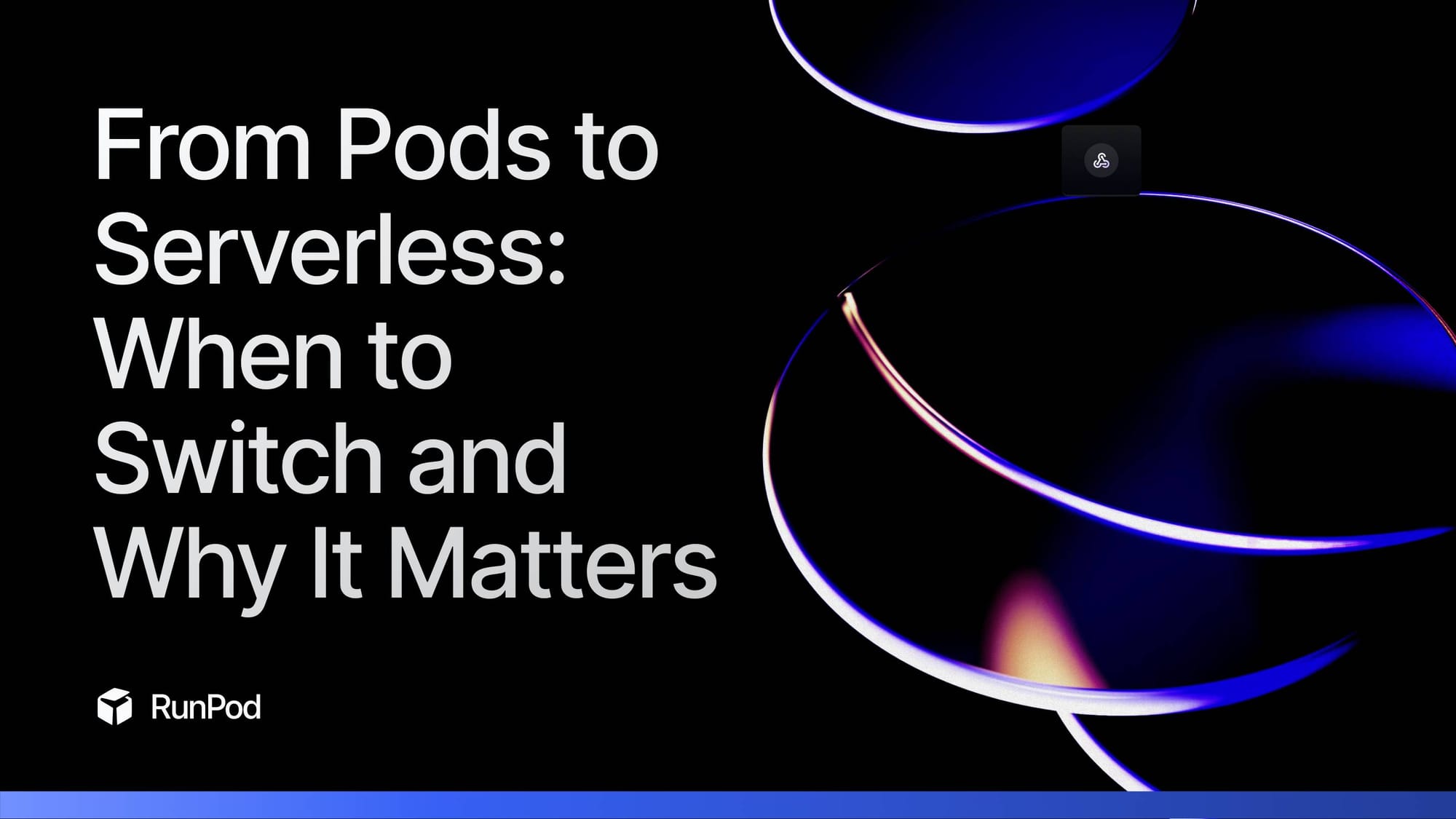From Pods to Serverless: When to Switch and Why It Matters

You’ve just finished fine-tuning your model in a pod. Now it’s time to deploy it—and you’re staring at two buttons: Serverless or Pod. Which one’s right for running inference?
If you’ve been using Pods to train, test, or experiment on RunPod, Serverless might be your next big unlock. This post breaks down the differences between the two, and helps you figure out when—and why—it makes sense to shift your workload to a lighter, faster, more scalable setup.
Whether you’re launching a product, preparing to serve real users, or looking to optimize GPU spend, this guide will help you decide when to move your model from Pods to Serverless for inference.
What Are RunPod Pods?
Pods are full-featured GPU environments you can shape to fit your exact needs. You pick the hardware, the image, the dependencies, the storage, and even the quirks. It’s your playground—with root access.
They’re perfect when you’re still building the thing: training foundation models, fine-tuning checkpoints, experimenting with prompts or workflows, or running a long simulation. If you need a persistent workspace, a multi-step pipeline, or a fully customizable system—Pods are your go-to.
What Is RunPod Serverless?
Serverless is what happens when your model grows up and moves out. You package it, hand it off, and we take care of the scaling, uptime, and GPU orchestration. All you do is point your app at a blazing-fast endpoint and start sending traffic.
You get sub-second startup times, per-second billing, and autoscaling baked in. It’s perfect for real-time inference, public APIs, and production workloads where cost and latency matter. No more GPU babysitting. No more idle burn.
Quick Comparison
| Feature | Serverless | Pods |
|---|---|---|
| Startup Time | Seconds | 2–3 minutes |
| Billing | Per second | Per minute |
| GPU Access | Abstracted | Full hardware access |
| Ideal For | Inference / APIs | Training, fine-tuning, research |
| Auto-scaling | Yes | No |
| Customization | Limited (via container config) | Full system-level control |
| Storage | Stateless or volume-mountable | Persistent volumes supported |
Why You Should Move from Pods to Serverless (When You're Ready)
The key question to ask yourself: Is this model for your team—or for the world?
- If you're still fine-tuning, iterating, or debugging with your team, stick with Pods. You’ll benefit from persistent storage, full hardware access, and a customizable environment tailored to experimentation.
- But if your model is ready to serve users—especially users beyond your internal team—it's time to move to Serverless. It gives you:
- A production-ready endpoint
- Per-second billing (no idle GPU costs)
- Built-in autoscaling
- Sub-second cold starts
Whether you're launching an app, building an API, or shipping a product, Serverless makes your model accessible at scale, with lower overhead and faster response times.
And unlike hosting providers with locked-down model libraries, RunPod Serverless is fully private—you control the endpoint, the container, and the access.
But Couldn’t I Just Autoscale My Own Pods?
We’ve heard this idea before: “Why not keep a pod warm and spin it up when traffic comes in?”
It’s tempting—but it misses what Serverless is really built for.
Yes, you could try to build your own scaling layer on top of Pods. You could script restarts, cache volumes, maybe even keep some paused pods around. But you’d still hit some hard limits:
- Cold start times: Spinning up a pod takes 2–3 minutes—even longer if you’re pulling a large image or mounting volumes. That’s fine for training. It’s a dealbreaker for real-time inference.
- Idle cost: Keeping pods paused or warm still burns budget. You’re paying for reservation, not usage.
- Manual orchestration: You’re now in the business of writing your own autoscaler—plus managing uptime, routing, and error handling.
Serverless takes all of that off your plate—with containerized deployments that spin up in seconds, scale automatically, and bill by the second. It's not just Pods with scripts—it’s an architecture built for real-time AI inference, and it shows.
Real-World Example
One startup fine-tunes a custom Mistral model in Pods using a nightly pipeline. Once they’re happy with the weights, they containerize it and deploy the model to RunPod Serverless as a high-availability endpoint that powers their app.
Another team iterates on RAG workflows and token filtering in Pods—then moves just the inference layer to Serverless to keep latency low and pricing predictable. It’s like bringing your model from the garage to the showroom.
You Don’t Have to Pick Just One
Pods are where ideas get built. Serverless is where they scale.
You don’t have to choose one forever—just the right one for your workload today. And moving between them is easier than you might think.
RunPod is built to support both workflows, with minimal friction and maximum flexibility.
Get Started
→ Launch a Serverless Endpoint
→ Join the RunPod Discord to get help choosing the right deployment path
